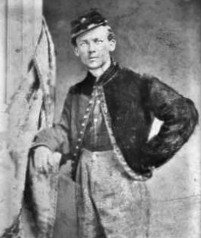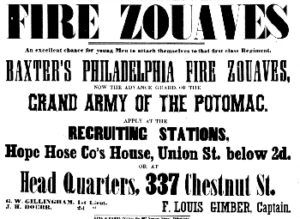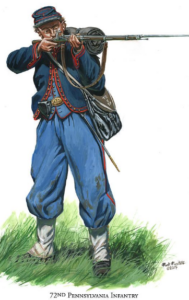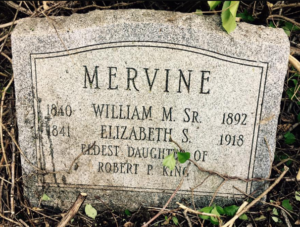Title: Army private, Civil War; attorney
Birthdate: May 22, 1840
Death Date: December 3, 1892
Plot Location: Section 40, Lot 229

The Mervine family has roots in Chester and Berks Counties, Pennsylvania going back to the 1700s. Each of William’s four great-grandfathers served in the Revolutionary War. His father, Thomas, owned an iron foundry and raised his family in Milton (derived from “mill town”) in the Susquehanna River Valley in east-central Pennsylvania, about 50 miles north of Harrisburg. There were a number of foundries in that region, but in the 1900s it became more well known for its production of tomatoes (and the exclusive home of Chef Boyardee canned pasta since 1938).
Thomas and wife Mary had nine children, William being the oldest, named after a pioneer in the iron industry, William McKinley. Mr. McKinley had a son in 1843 named William McKinley, Jr. who became the 25th U.S. President in 1897.
As the family business prospered, two of the boys went on to higher education and city life, and both are buried here at Mount Moriah. William was the first to go to Philadelphia, where he was a law student in 1860. He was followed 20 years later by Charles who first went to Yale and then became a Methodist minister here. But William’s studies at law school were interrupted by a call to arms.
He enlisted on August 10, 1861 with Company E of the 72nd Pennsylvania Volunteer Infantry. They were also known as Baxter’s Fire Zouaves, after Colonel Dewitt Clinton Baxter. He recruited men  from fire stations throughout Philadelphia and Delaware Counties, and adopted the “Zouave” style of uniform shown here: light blue baggy trousers, dark blue jacket with 16 brass buttons and red trim on everything, along with white gaiters over their ankles. Some other Zouave units had fez caps or even turbans.
from fire stations throughout Philadelphia and Delaware Counties, and adopted the “Zouave” style of uniform shown here: light blue baggy trousers, dark blue jacket with 16 brass buttons and red trim on everything, along with white gaiters over their ankles. Some other Zouave units had fez caps or even turbans.
 The 72nd Regiment was part of the “Philadelphia Brigade,” the only brigade in the Federal army to carry the name of a city. It fought in several major battles, including the battles of Antietam, Fredericksburg, Gettysburg, and the Overland Campaign. A total of 1,600 men fought in the 72nd, of whom 1,053 became casualties, which includes those who were killed, wounded, died of disease, captured, or missing.
The 72nd Regiment was part of the “Philadelphia Brigade,” the only brigade in the Federal army to carry the name of a city. It fought in several major battles, including the battles of Antietam, Fredericksburg, Gettysburg, and the Overland Campaign. A total of 1,600 men fought in the 72nd, of whom 1,053 became casualties, which includes those who were killed, wounded, died of disease, captured, or missing.
William was wounded in an engagement at Harper’s Ferry in mid-September, 1862. It was fortunate he was taken off duty to recover because the battle of Antietam followed two days later, where nearly half the regiment was lost. He recovered and rejoined his company, although when and where is unknown. His obituary, below, says he continued to suffer from his injury long after the war was over. Along with the other original members of the Fire Zouaves, William was discharged when his term expired on August 24, 1864.
The ex-soldier returned to Philadelphia to finish his degree and become a member of the bar. While doing that he met and fell in love with Elizabeth Shaw King, daughter of Robert Pennock King. He was the owner of a prominent publishing house, a civic leader, and founding member of this cemetery, whose own Notable story is found here. Unfortunately he died at home, 522 Spruce Street in Society Hill on September 27, 1868. Elizabeth and William were married there a few weeks later, on November 12.
William brought Elizabeth home to Milton where he set up his practice, became involved in the little community, and they had all four of their children. The business directory of 1871 shows his office was on the same street as his father’s business, the Mervine & Lawson Foundry, co-owned by John Lawson. A relative, W.C. Lawson, ran one of the two banks and was a partner in the more well-established law practice in town.
William diversified his interests as well, becoming a partner in Morton, Mervine & Company, publishers of one of the town’s two weekly newspapers, The Miltonian. However, his law practice didn’t thrive as expected; the 1873 business directory only lists his newspaper business.
So the family moved in 1875 to Philadelphia, where life  was better. His office was at 524 Walnut Street overlooking Independence Hall, he joined the veterans’ group, the Grand Army of the Republic, in 1877, and he even bought property in Ocean City, New Jersey. For the next 17 years the children grew up in the neighborhood around Montgomery and North 20th Street known as North Philadelphia/West.
was better. His office was at 524 Walnut Street overlooking Independence Hall, he joined the veterans’ group, the Grand Army of the Republic, in 1877, and he even bought property in Ocean City, New Jersey. For the next 17 years the children grew up in the neighborhood around Montgomery and North 20th Street known as North Philadelphia/West.
In 1880 the government approved a disability pension for William, which continued until his death in 1892 at age 52. Burial was in Elizabeth’s family plot, where she was placed in 1918. Their son, William Jr., and his wife and other Mervines were also buried there. William’s brother, Rev. Charles Mervine, and his wife were buried in Section 131, Lot 65.

Support the Friends of Mount Moriah
Help us in our mission to restore and maintain the beautiful Mount Moriah Cemetery by donating to our cause or volunteering at one of our clean-up events.

